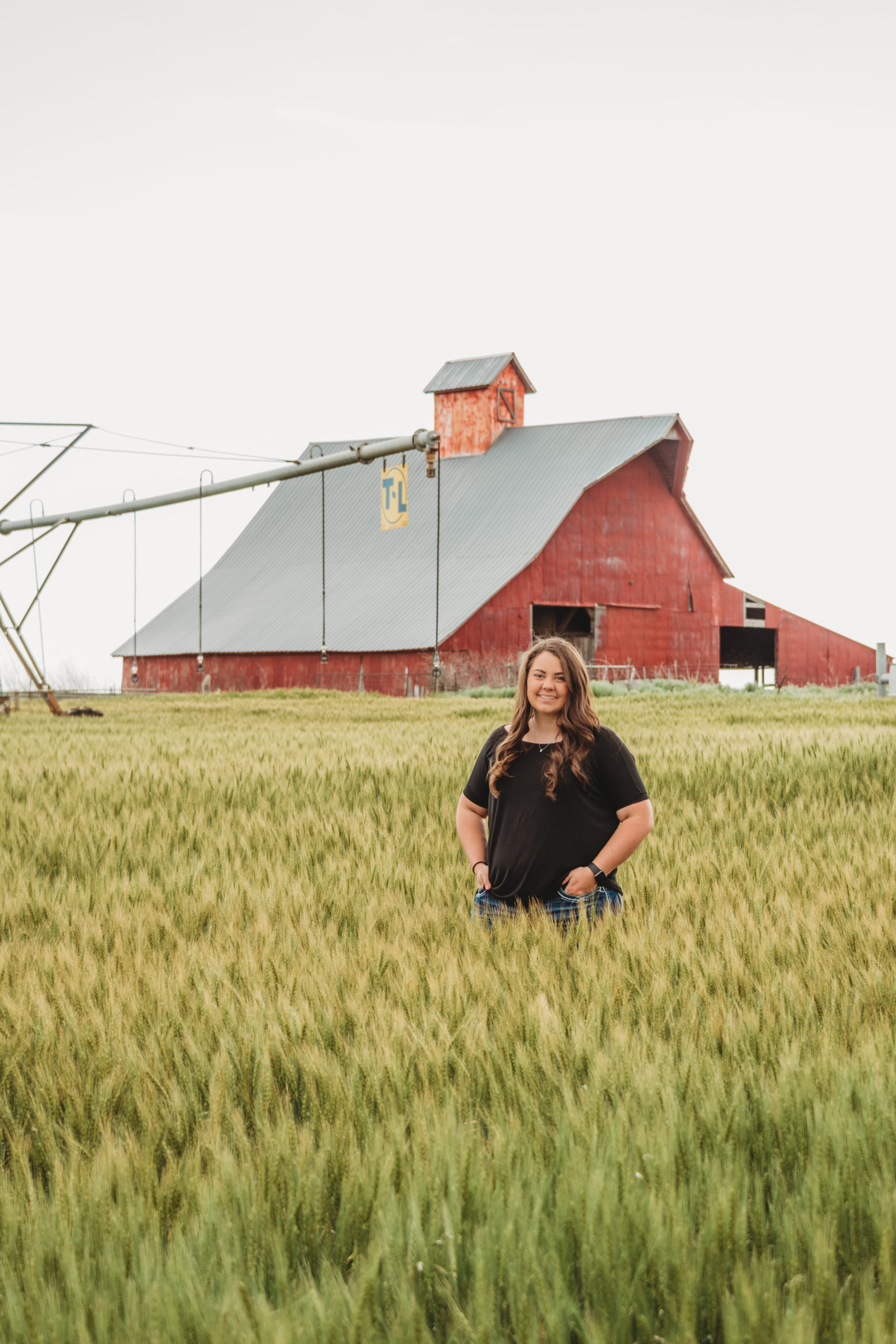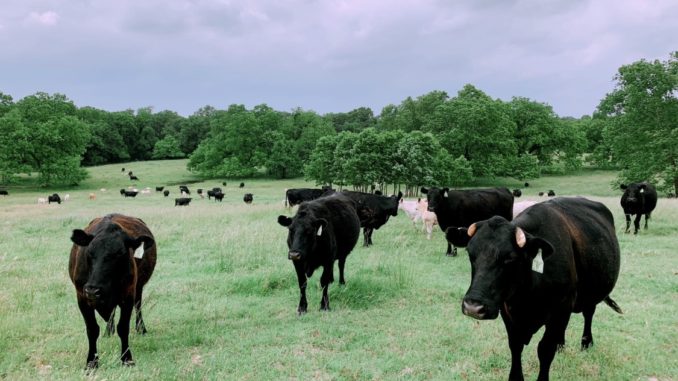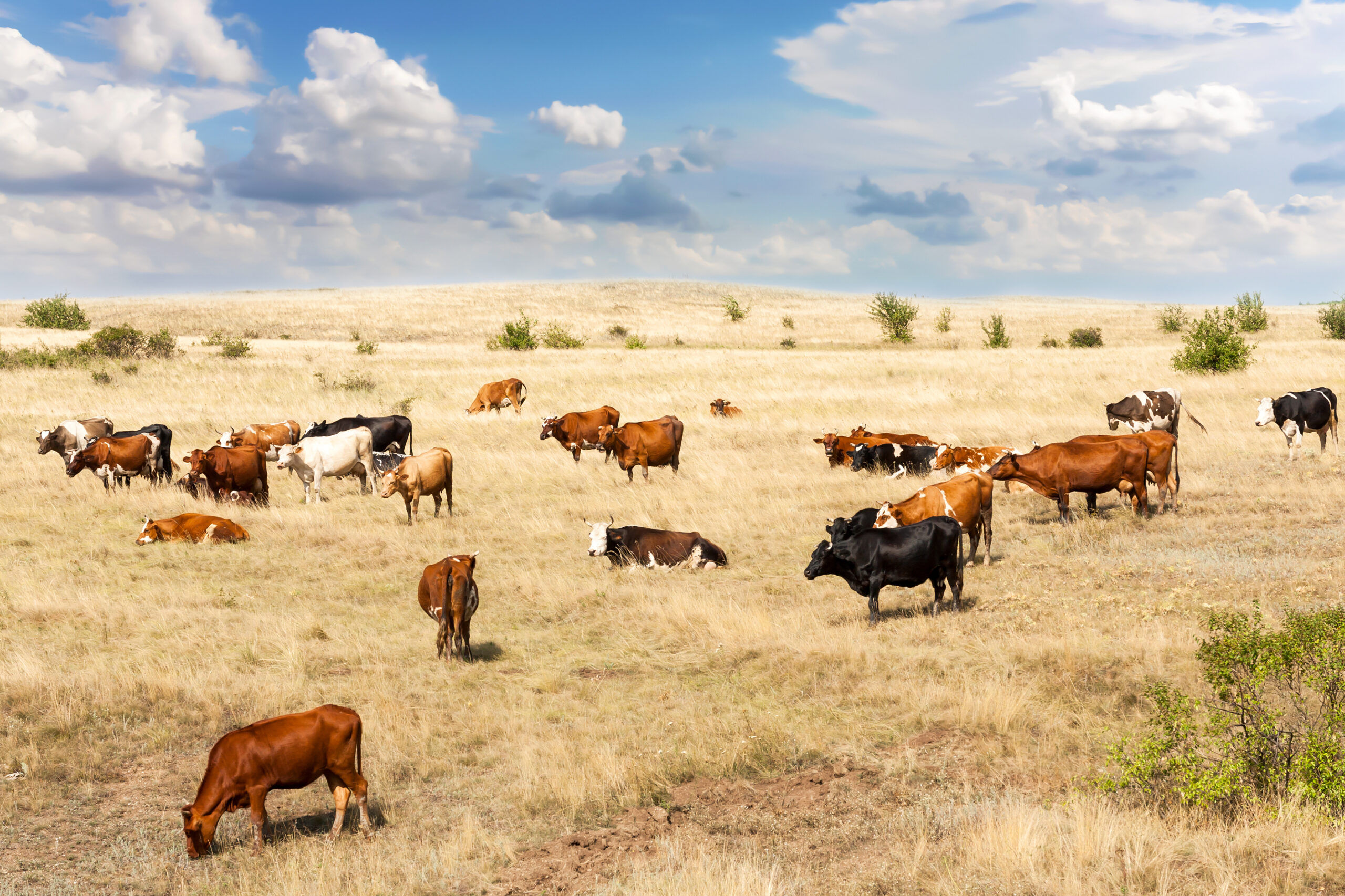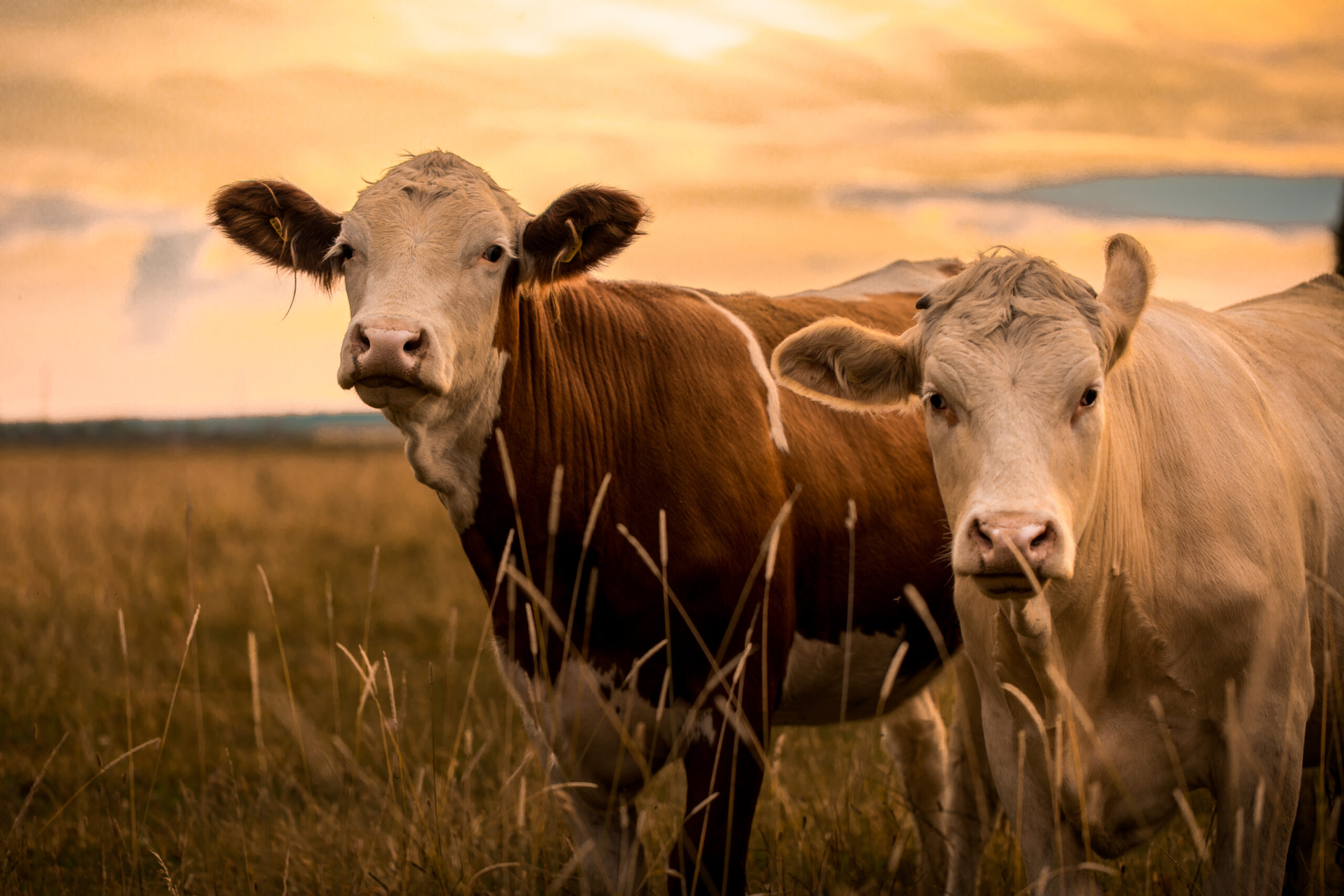Farm & Ranch
Balancing Act – Brittany Hukill

Some of her earliest memories are of her, cuddled in a quilt on the floor of the tractor cab as her father worked in his fields. “I’m not really sure how there was enough room, because we still have some of those tractors,” Brittany Hukill, of Hinton, Okla., laughed. “I have those memories of growing up on the farm and growing up in the middle of it made me realize that there is a lot you can learn just by being around it. My dad didn’t force me to work when I was that small, but because I was around it, I have a love for being in a tractor and a combine, just because that’s what I did when I was little.”
Brittany Hukill is a fifth generation farmer in Western Oklahoma, and at only 24 years old, is in charge of day-to-day operations of Krehbiel Farms and Southwest Center Pivots. She’s actively involved in several farming organizations, and she and her husband are expecting their first child this fall. To say she’s busy is more than an understatement.
To understand Brittany’s love of the land and farming, it’s important to go back more than a century ago, when her great great grandfather, Jacob A. Pankratz, traded a wagon full of oats and a team of mules for the first quarter of land her family owned. “That was back in the early 1900s, and then that farmland has been passed down through generations. The second generation was a daughter, Margaret (Pankratz) Krehbiel, and she married my great grandpa Val and joined into the Krehbiel family, and that carried down to my grandpa, my dad, and then me,” she explained.
Brittany, born in 1995, grew up on the farm. Her dad, Jeff Krehbiel, farmed full time with his father Wayne Krehbiel, and eventually purchased the farming operation with his wife Karen in 1998. The farming operation consists of commercial sheep, and their main crop is seed wheat which are mostly varieties from the Oklahoma State breeding program. They also have farmed alfalfa, milo, canola, soy beans and peanuts.
Wayne started Southwest Center Pivots in the early 1980s. To get through the farm crisis, he began selling the irrigation systems out of a hardware store he owned in Hydro. He sold the irrigation systems to local people, but then business continued to spread, and now, almost 40 years later, systems are sold all across the state of Oklahoma and about 50 miles into the surrounding states.
Tragedy struck the family in 2009 when Jeff was diagnosed with brain cancer. He died two short years later, when Brittany was only 15. Just before her dad passed, she made a promise to him that she would come back to the farm. “I planned to go to Oklahoma State University, and return home to farm after graduation,” she shared.
With the help of her grandfather, Brittany and her mother, an accountant by trade, kept the farm and irrigation system running while she was away. In the busiest times of the year, that meant that Brittany would be making the almost two-hour drive home every weekend.
Sadly, Wayne passed away in 2016, when Brittany still had a year of college left. She was able to finish a semester early and kept her promise to return to the farm.
“It was extremely difficult on my mom and me after they passed. It was tough, but I know it was by God’s grace that we survived. Between my dad’s death and then my grandfathers, we would not be where we are without God. There is no way to handle that kind of loss and survive on your own.” She added, “I just think it’s impossible to go through not only being a farmer, but to go through loss without the hope that we have because of Christ. I don’t see how other people would be able to do it, and I fully credit our ability to survive based on that.”
It’s bittersweet, but Hukill knows her father’s death likely allowed her to raise her family on the same land. “Before dad got sick, I didn’t really know if there would be room for me because a farm can only sustain so many generations at one time, so I didn’t know what opening there would be for me,” she said, her voice catching slightly. “When he died, I knew there would be an opening for me that there might not have been. But, I also worried that it might fall apart because he was gone. I have no doubt that if dad were here, he would be so proud and excited to see what’s happening on the farm. I try to avoid “what-if” scenarios because I can’t change what’s happened, and those things have made me who I am. At the same time, getting to farm and run our irrigation business with dad would have been so much fun. I miss his humor and laugh almost daily, even after eight years. When you spend your life working on the farm, you always hope the next generation will pick up where you leave off and continue on in an even better direction. I think where we are now and the steps we are taking for the future would make all of the generations before me proud, at least I hope they would.”
While her mom still works on the accounting and books, Brittany can typically be found taking care of daily operations of the farm and irrigation business. The only thing that could be typical is that there are few days that are. On any given day you can catch her scheduling employees, meeting irrigation customers, running for parts or supplies, sending out billing for the irrigation business, working in the fields or doing projects around the farm with her husband.
Becoming Brittany Hukill
It was while at OSU that Brittany met Logan Hukill, a young man originally from the Altus area. The pair met at the beginning of Brittany’s sophomore year. “I was very cautious when I was in college, because I didn’t want people to know my family had a farm and irrigation business. I knew it would be attractive to some people, so I just kept that information contained,” she shared.
It was during one of their very first conversations that Logan shared his hopes for the future. “He said, ‘I want to do health care, because I feel like that’s where God wants me to be. But I also do not want to live in the city. I want to live an hour or so outside the city on a farm or ranch with animals and livestock.’ I thought that it might work, and I knew he was genuinely looking for someone, not an opportunity. As time went on, I realized it would work,” she said.
The pair were married in 2018. Logan now works as a registered nurse in the emergency room in the Integris Baptist Medical System in Oklahoma City. “He works on the farm on his days off. We have a little bit of role reversal of what people would think is typical, but it works for us,” she said.
With the onslaught of the COVID-19 pandemic, Brittany and Logan have taken a few extra precautions, but they don’t let fear rule their lives. “It’s been interesting. We have a system for when he gets home from work, but, if I’ve learned anything in my few years here on earth, I know I can’t live in fear. I have lost lots of people I love, and I just don’t have the time or the brain capacity to be fearful. If I was going to be afraid of everything that could possibly kill me, I wouldn’t get anything done.” She added, “So yes, we’re careful, but at the end of the day, we have to live.”
The Hukills are expecting their first child in September, and Brittany is looking forward to raising her child as she was. “My plan is for me to be able to slow down a little bit, because we’ll be headed into the winter months, so the irrigation business will start to slow down. I’m hoping to be able to take a few months to just be with the baby. I know I’ll have to get the guys out the door first thing in the morning, but then I can go back to being mom,” she said.
Farm & Ranch
Cattle Nematodes (Worms)

Barry Whitworth, DVM | Senior Extension Specialist | Department of Animal & Food Sciences
According to the Mesonet, Oklahoma received some much-needed rain in late April (2023). With the moderate temperatures and high humidity, the environment is perfect for the proliferation of gastrointestinal nematodes (GIN) which are commonly called “worms.” Cattle can be infected with a variety of GIN. Most do not cause issues unless husbandry practices are poor. However certain GIN have been associated with disease. The most pathological GIN in cattle is Ostertagia ostertagi. Cooperia species and Haemonchus species are two that have been implicated with production issues. Control of these parasites is constantly changing due to environment, anthelmintic (dewormer) resistance, and consumer preference. Cattle producers should develop a plan to manage these parasites.
In order for GIN to complete their life cycle, certain environmental conditions must exist. The development stage begins with passing of the egg in the feces of the animal. If the egg is to hatch, the temperature must be warm and the humidity needs to be close to 100%. Ideal temperature ranges from 70⁰ to 80⁰ Fahrenheit (F), but any temperature above 45⁰ F will allow for development. Temperatures above 85⁰ F or below 45⁰ F will begin to hamper development. Humidity needs to be 80% or higher.
Once the egg hatches, the larva goes through a couple of molts to reach the infective stage which is the third stage larva (L3). L3 must have moisture to free itself from the fecal pat. Once free, it rides a wave of water on to a blade of forage. Once ingested, this begins the prepatent or pre-adult stage. Two molts take place during this stage (L3 to L4 and L4 to L5). If conditions are not favorable for survivability of offspring, L4 will go into an arrested development stage (hypobiosis) for a period of time. The patent or adult stage is the mature breeding adult.
Once inside the body, the parasite will migrate to certain locations in the digestive tract. For example, O. ostertagi develop in the gastric gland in the abomasum. H. placei and H. contortus will migrate to the abomasum. Cooperia species will live in the small intestine. A few like Trichuris (whipworms) are found in the large intestine.
Clinical signs of parasitism vary according to the species of parasite, burden, and site of attachment. Severe disease, which is referred to as parasitic gastroenteritis (PGE), with internal parasites is unusual with today’s control methods. Clinical signs of PGE are lack of appetite, weight loss, weakness, diarrhea, submandibular edema (bottle jaw), and death. However, most parasite infection are subclinical which means producers do not see clinical signs of disease. In subclinical infections, the parasite causes production issues such as poor weight gain in young cattle, reduced milk production, and lower pregnancy rates.
Producers should be monitoring their herds for parasites throughout the year but especially in the spring when conditions are ideal for infection. A fecal egg count (FEC) is a good way of accessing parasite burdens. Livestock producers need to gather fecal samples from their herd periodically. The samples should be sent to their veterinarian or a veterinary diagnostic lab. Different techniques are used to access the number of eggs per gram of feces. Based on the counts, the producer will learn the parasite burden of the herd. Producers can use this information to develop a treatment plan.
In the past, GIN control was simple. Cattle were routinely dewormed. Unfortunately, anthelmintic resistance has complicated parasite control. Now proper nutrition, grazing management, a general understanding of how weather influences parasites, biosecurity, refugia, anthelmintic efficiency, and the judicious use of anthelmintics are important in designing an effective parasite management program. All of these considerations need to be discussed in detail with a producer’s veterinarian when developing a plan for their operation.
Cattle producers need to understand that parasites cannot be eliminated. They must be managed with a variety of control methods. Designing a parasite management plan requires producers to gain a general understanding of life cycle of the parasite as well as the environmental needs of the parasite. Producers should use this information as well as consult with their veterinarian for a plan to manage GIN. For more information about GIN, producers should talk with their veterinarian and/or with their local Oklahoma State University Cooperative Extension Agriculture Educator.
References
Charlier, J., Höglund, J., Morgan, E. R., Geldhof, P., Vercruysse, J., & Claerebout, E. (2020). Biology and Epidemiology of Gastrointestinal Nematodes in Cattle. The Veterinary clinics of North America. Food animal practice, 36(1), 1–15.
Navarre C. B. (2020). Epidemiology and Control of Gastrointestinal Nematodes of Cattle in Southern Climates. The Veterinary clinics of North America. Food animal practice, 36(1), 45–57.
Urquhart, G. M., Armour, J., Duncan, J. L., Dunn, A. M., & Jennings, F. W. (1987). In G. M. Urquhart (Ed). Veterinary Helminthology. Veterinary Parasitology (1st ed., pp 3-33). Longman Scientific & Technical.
Farm & Ranch
The Value of Vitamin A

Barry Whitworth, DVM – Area Food/Animal Quality and Health – Specialist for Eastern Oklahoma
A ranch in Australia experienced an abnormally high number of stillbirths and weak born calves in 2004-2005. An investigation revealed that the usual infectious causes were not the problem. After additional testing, veterinarians diagnosed low levels of vitamin A as the cause.
According to Dr. Greg Hanzlicek, with the Kansas State Veterinary Diagnostic Laboratory (KSVDL), Kansas had an unusually high number of stillbirth cases and weak born calves in the spring of 2019. After many laboratory tests, it was concluded that the problem stimmed from a lack of energy, protein, Vitamin A, or combinations of all of these.
Both of the above examples demonstrate the importance of vitamin A in reproductive efficiency. Research has shown that low vitamin A levels during pregnancy are associated with abortions, stillbirths, and weak born calves. In addition to playing an important role in reproductive efficiency, vitamin A is essential for vision, bone growth, and maintaining epithelial tissue such as skin and hooves.
Animals obtain vitamin A from consuming green forage and/or the addition of vitamin A supplements to the diet. Lush green pastures contain high amounts of vitamin A. As plants mature and during times of drought, the amount of vitamin A decreases. The ranch in Australia experienced below average rainfall in the previous two years prior to the calving season. During the calving season, rainfall was below average with very dry conditions and little green forage was available.
In general, animals obtain adequate amounts of vitamin A by grazing green forage. Animals grazing green pastures will build a healthy store of vitamin A in the liver. When vitamin A is in short supply, the stores in the liver prevent deficiencies. According to Dr. Lalman, Extension Beef Cattle Specialist Oklahoma State University, the stores should last 2 to 4 months during times of deficiency. During times when green forage is not available, vitamin A supplements need to be added to the diet to prevent deficiencies.
When vitamin A levels are deficient, night blindness is one of the earliest clinical signs. Other eye issues include clouding of the cornea, ocular discharges, and possible ulcerations. Skin issues found when levels of vitamin A are deficient include a dry rough coat, scales on the skin, and dry cracked hooves. Other neurological signs include incoordination or gait problems. Seizures may occur due to the increase cerebrospinal fluid pressure. Birth defects have also been attributed to low vitamin A levels.
Animals displaying vitamin A deficiency should be treated immediately with vitamin A injections. If treated early, response is usually rapid and complete. However, delaying treatment may result in irreversible damage. Even with treatment, cattle with vision impairment due to vitamin A deficiency may not regain their sight.
Preventing Vitamin A deficiency depends on producers being attentive to the environmental conditions that favor low vitamin A levels in forage. During these times, producers need to supplement the diet with vitamin A. Producers need to be aware that Vitamin A supplements degrade rapidly, so vitamin A supplements should not be stored for long periods of time. In addition to vitamin A supplementation, research indicates that diets low in protein result in poor absorption of vitamin A. It is important that producers ensure that the rations have sufficient protein levels. Lastly, since colostrum contains high levels of vitamin A, producers need to ensure that newborns obtain adequate amounts of colostrum at birth.
Similar to the Australian example, most of Oklahoma had below average rainfall for the year of 2022. This resulted in pasture quality decreasing earlier than normal. Due to this year’s lack of green forage, liver stores of vitamin A may be inadequate for the animal’s needs. Producers need to ensure that the diets of their cattle have adequate amounts of vitamin A, energy, and protein. For more information about Vitamin A, producers should contact their veterinarian and/or visit with their Oklahoma State University County Ag Educator.
References
Hanzlicek, G. (2019, May). Difficult Calving Season Findings:2019. Diagnostic Insights. www.ksudl.org/resources/news/diagnostic_insights/may2019/difficult-calving-season2019.html.
Hill, B., Holroyd, R., & Sullivan, M. (2009). Clinical and pathological findings associated with congenital hypovitaminosis A in extensively grazed beef cattle. Australian Veterinary Journal, 87(3), 94–98.
Parker, E. M., Gardiner, C. P., Kessell, A. E., & Parker, A. J. (2017). Hypovitaminosis A in extensively grazed beef cattle. Australian veterinary journal, 95(3), 80–84.
Farm & Ranch
Lice in Cattle

Barry Whitworth, DVM, MPH | Senior Extension Specialist
Department of Animal & Food Sciences | Freguson College of Agriculture | Oklahoma State University
Cattle lice cost Oklahoma cattlemen millions of dollars each year in decreased weight gains and reduced milk production. If cattle producers have not treated their cattle for lice this fall, they need to consider what type of lice control to initiate. This is especially true for cattle producers that had problems in the previous year. Cattle producers should monitor cattle closely during the months of December, January, and February. Producers should not wait until clinical signs appear before beginning treatment.
The life cycle of the different species of cattle lice are very similar. The life cycle begins with the female louse attaching her egg to a shaft of hair. The egg will hatch as a small replica of the adult. After several molts, the adult will emerge. The cycle takes around 3 to 4 weeks to complete. These newly hatched lice will spend their entire life on the host and are host specific which means cattle cannot be infected with lice from other animals.
Small numbers of lice may be found on cattle in the summer, but high populations of lice are associated with cold weather. Since cattle tend to be in closer proximity to each other in the winter, lice can spread easily between cattle. A small percentage of cattle tend to harbor larger numbers of lice. These animals are sometimes referred to as “carrier animals”, and they may be a source for maintaining lice in the herd. As with many other diseases, stress also contributes to susceptibility and infestation.
Signs of lice infections in cattle are hair loss, unthrifty cattle, and hair on fences or other objects. If producers find these signs, they may want to check a few animals for lice. They can check for lice by parting the hair and observing the number of lice per square inch. If an animal has 1 to 5 lice per square inch, they are considered to have a low infestation. Cattle with 6 to 10 lice would be considered moderately infested. Any cattle with more than 10 lice per square inch are heavily infested.
Cattle have two types of lice. One type is the biting or chewing louse. These lice have mouth parts that are adapted to bite and chew the skin. The second type is sucking louse. These lice have mouth parts that will penetrate the skin and suck blood and other tissue fluids. It is not uncommon for cattle to be infested with more than one species of lice.
The biting or chewing louse is Bovicola (Domalinia) bovis. This type of lice feeds on hair, skin, skin exudate, and debris. Typical clinical signs with this type of louse are hair loss, skin irritation and scabs on the skin. They are found on the shoulders and back.
Four types of sucking lice can be found in the United States. The first is the “short nose” louse or Haematopinus eurysternus. This is the largest cattle louse. This louse is found on the neck, back, dewlap, and base of the tail. The second is the “long-nose” louse or Linognathus vituli. This louse is bluish in color with a long slender head. This louse is found on the dewlap, shoulders, sides of the neck, and rump. The third is the “little blue” louse or Solenoptes cappilatus. This louse is blue in color and is the smallest cattle louse. This louse is found on the dewlap, muzzle, eyes, and neck. The last is the “tail” louse or Haematopinus quadripertuses. This louse has been found in California, Florida, and other Gulf Coast States. This louse is found around the tail.
The sucking lice have the potential to cause severe anemia if the numbers are high. This can result in poor doing cattle or in extreme cases death. They also can spread infectious diseases. The long-nose louse has been found to be a mechanical vector for anaplasmosis.
Prevention of lice infestation should begin in the fall. Producers should not wait for clinical signs to appear before beginning treatment. Several products are available to control lice. Producers should read and follow the label directions. Producers should keep in mind that many of the lice control products require two administrations to control lice. Failure to do this may result in cattle having problems with lice infestations.
Some producers have complained that some products do not work. These complaints have not been verified; however, this is a good reason to consult with a veterinarian for advice on what products to use. Most treatment failures are associated with incorrect application not resistance. Proper application of Pour-On insecticides is to administer from the withers to the tailhead. Also, the proper dose is essential for good control.
Cattle producers need to consider a few other things in lice control. Since cattle in poor body condition are more prone to lice infestation, producers need to be sure that the nutritional needs of their cattle are being met. Cattle that have a history of lice infestations should be culled. Lastly, any purchased cattle need to be inspected for lice before entering the herd. If lice are found, the animals should be isolated and treated before entering the herd.
If producers would like more information on lice in cattle, they should contact their local veterinarian or Oklahoma State University County Extension Agriculture Educator. They may also want to read Oklahoma Cooperative Extension Fact Sheet Beef Ectoparasites VTMD-7000 at https://extension.okstate.edu/fact-sheets/beef-cattle-ectoparasites.html.
-

 Attractions8 years ago
Attractions8 years ago48 Hours in Atoka Remembered
-

 Country Lifestyle8 months ago
Country Lifestyle8 months agoJuly 2017 Profile: J.W. Hart
-

 Country Lifestyle9 years ago
Country Lifestyle9 years agoThe House a Treasure Built
-

 Country Lifestyle3 years ago
Country Lifestyle3 years agoThe Two Sides of Colten Jesse
-

 Outdoors7 years ago
Outdoors7 years agoGrazing Oklahoma: Honey Locust
-

 Equine8 years ago
Equine8 years agoUmbilical Hernia
-

 Outdoors5 years ago
Outdoors5 years agoPecan Production Information: Online Resources for Growers
-

 Farm & Ranch7 years ago
Farm & Ranch7 years agoHackberry (Celtis spp.)




